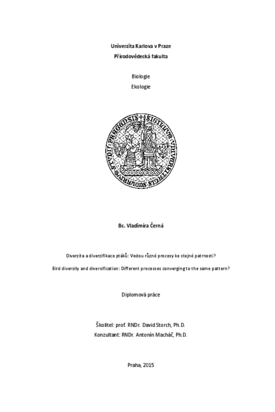Diverzita a diverzifikace ptáků: Vedou různé procesy ke stejné patrnosti?
Bird diversity and diversification: Different processes converging to the same pattern?
diploma thesis (DEFENDED)

View/
Permanent link
http://hdl.handle.net/20.500.11956/61987Identifiers
Study Information System: 130237
Collections
- Kvalifikační práce [19613]
Author
Advisor
Referee
Hulva, Pavel
Faculty / Institute
Faculty of Science
Discipline
Ecology
Department
Department of Ecology
Date of defense
1. 6. 2015
Publisher
Univerzita Karlova, Přírodovědecká fakultaLanguage
Czech
Grade
Very good
Keywords (Czech)
fylogeneze, diverzifikace, evoluce, radiace, gradienty diverzityKeywords (English)
phylogeny, diversification, evolution, radiation, diversity gradientsLatitudinální gradient diverzity je jeden z nejdéle známých trendů v rozložení života na Zemi. Více než dvě stovky let se vědci snaží nalézt faktory, které stojí za jeho vznikem. K jeho vysvětlení bylo navrženo hned několik hypotéz. V posledních letech je to jedno z hlavních témat diskuze mezi ekology a evolučními biology. Svou diplomovou prací se pokusím přispět k poznání procesů, které latitudinální gradient diverzity utvářejí. Zajímá mě především, zda je vztah mezi teplotou prostředí a rychlostí diverzifikace. Liší se tento vztah u jednotlivých skupin živočichů? Zvolila jsem si ptáky jako modelovou skupinu. Konkrétně těchto šest čeledí: Accipitridae, Columbidae, Furnariidae, Picidae, Psittacidae a Strigidae. Vybrané skupiny zahrnují více než 1500 druhů. Všech šest čeledí vykazuje, pro ptáky univerzální, latitudinální gradient diverzity. Mým cílem bylo zjistit, zda tyto univerzální gradienty diverzity ptáků byly utvářeny stejnými historickými procesy. Případně, zda různé evoluční trajektorie konvergovaly ke stejným gradientům. Výsledkem mé práce je zjištění, že některé čeledi diverzifikovaly rychleji v teplejším prostředí (Psittacidae, Strigidae), zatímco jiné naopak akumulovaly diverzitu rychleji v chladnějším prostředí vyšších zeměpisných šířek (Accipitridae). Další skupiny diverzifikovaly...
Latitudinal diversity gradient is one of the oldest known trends in the distribution of life on the Earth. Scientists have been trying to find causes of its formation for more than two hundred years. There are several hypotheses suggested to explain this gradient. Recently, it is one of the main themes of discussion among ecologists and evolutionary biologists. By this Thesis, I will try to contribute to understanding of processes that generate the latitudinal diversity gradient. Particularly, I study if there is a relationship between ambient temperature and diversification rate. Is this relationship different for individual groups of animals? I choose birds as a model group. Specifically, these six families of birds: Accipitridae, Columbidae, Furnariidae, Picidae, Psittacidae and Strigidae. These groups include more than 1500 species. Each of them has the same universal gradient of diversity, with the highest diversity concentrated in the tropics. My objective was to find out, whether the universal gradients of bird's diversity had been shaped by the same historical processes. Or alternatively, whether different evolutionary trajectories had converged to the same gradients. The main outcome of my work is a discovery that some of the selected families diversified faster in warmer climates...
